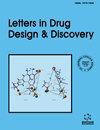Structural Optimization of Quinazolin-4-One Derivatives as Novel SARS-CoV-2 Mpro Inhibitors by Molecular Simulation
IF 1.6
4区 医学
Q4 CHEMISTRY, MEDICINAL
引用次数: 0
Abstract
Background: Severe acute respiratory syndrome coronavirus 2 main protease (SARSCoV- 2 Mpro) has been shown to be an effective target for inhibiting novel coronaviruses, which can be used as a crucial breakthrough for developing drugs to treat the coronavirus disease 2019 (COVID-19). Methods: To design novel SARS-CoV-2 Mpro inhibitors, we conducted 3D-QSAR, molecular docking, and molecular dynamics (MD) simulation on 64 quinazolin-4-one derivatives. Results: Comparative molecular field analysis (CoMFA) model (q2 = 0.590, R2 = 0.962), comparative molecular similarity index analysis (CoMSIA) model (q2 = 0.628, R2 = 0.923), and external validation indicated that the stability, reliability, and prediction performance of our constructed model were excellent. We designed 8 inhibitors with stronger antiviral activities through the three-dimensional equipotential field. Molecular docking and MD simulation probed the interactions of compounds and SARS-CoV-2 Mpro. This indicated that amino acid residues, including Met165, Met49, and Cys145, were very important in combination with the compounds. The prediction results of ADME/T and Lipinski’s rule of five indicated that the new compounds had favorable drug-like and pharmacokinetic properties. Conclusion: This study provides new ideas for exploring new drugs against COVID-19通过分子模拟优化喹唑啉-4-酮衍生物作为新型 SARS-CoV-2 Mpro 抑制剂的结构
背景:严重急性呼吸系统综合征冠状病毒 2 主蛋白酶(SARSCoV- 2 Mpro)已被证明是抑制新型冠状病毒的有效靶点,可作为开发治疗 2019 年冠状病毒病(COVID-19)药物的重要突破口。方法:为设计新型 SARS-CoV-2 Mpro 抑制剂,我们对 64 个喹唑啉-4-酮衍生物进行了三维-QSAR、分子对接和分子动力学(MD)模拟。结果比较分子场分析(CoMFA)模型(q2 = 0.590,R2 = 0.962)、比较分子相似性指数分析(CoMSIA)模型(q2 = 0.628,R2 = 0.923)和外部验证表明,我们构建的模型具有良好的稳定性、可靠性和预测性能。通过三维等势场,我们设计了 8 种具有较强抗病毒活性的抑制剂。分子对接和 MD 模拟探究了化合物与 SARS-CoV-2 Mpro 的相互作用。结果表明,Met165、Met49和Cys145等氨基酸残基与化合物的结合非常重要。ADME/T 和 Lipinski's rule of five 的预测结果表明,新化合物具有良好的类药物特性和药代动力学特性。结论本研究为探索针对 COVID-19 的新药提供了新思路。
本文章由计算机程序翻译,如有差异,请以英文原文为准。
求助全文
约1分钟内获得全文
求助全文
来源期刊
CiteScore
1.80
自引率
10.00%
发文量
245
审稿时长
3 months
期刊介绍:
Aims & Scope
Letters in Drug Design & Discovery publishes letters, mini-reviews, highlights and guest edited thematic issues in all areas of rational drug design and discovery including medicinal chemistry, in-silico drug design, combinatorial chemistry, high-throughput screening, drug targets, and structure-activity relationships. The emphasis is on publishing quality papers very rapidly by taking full advantage of latest Internet technology for both submission and review of manuscripts. The online journal is an essential reading to all pharmaceutical scientists involved in research in drug design and discovery.

 求助内容:
求助内容: 应助结果提醒方式:
应助结果提醒方式:


